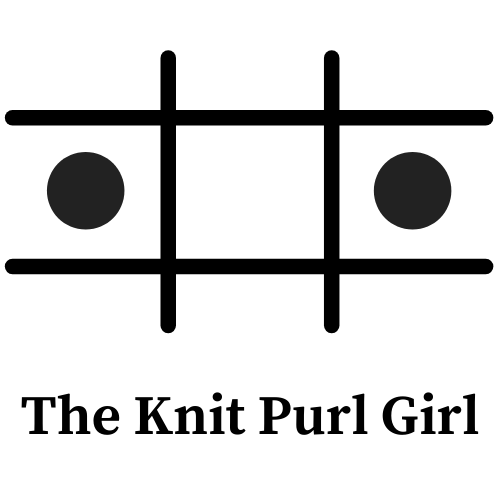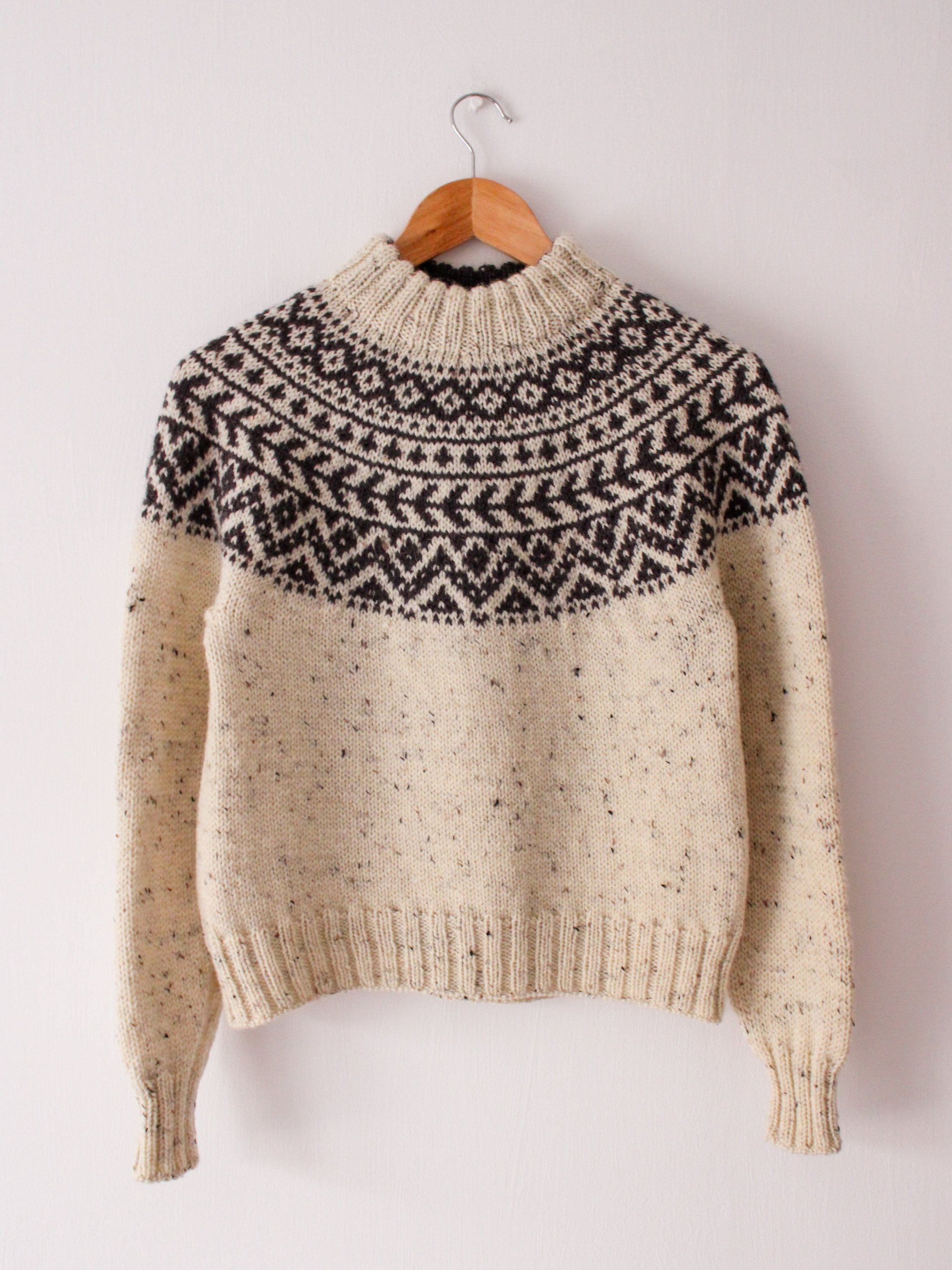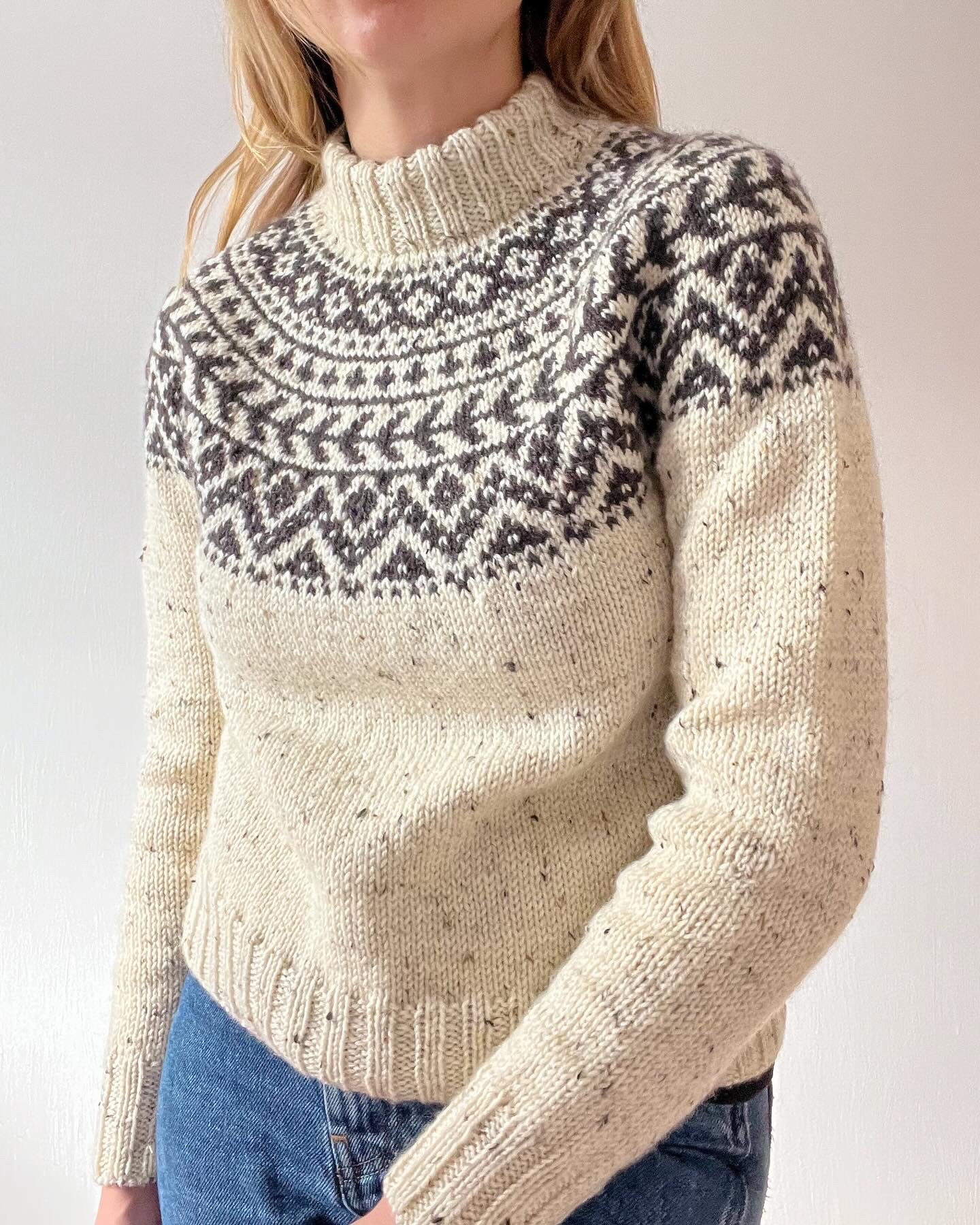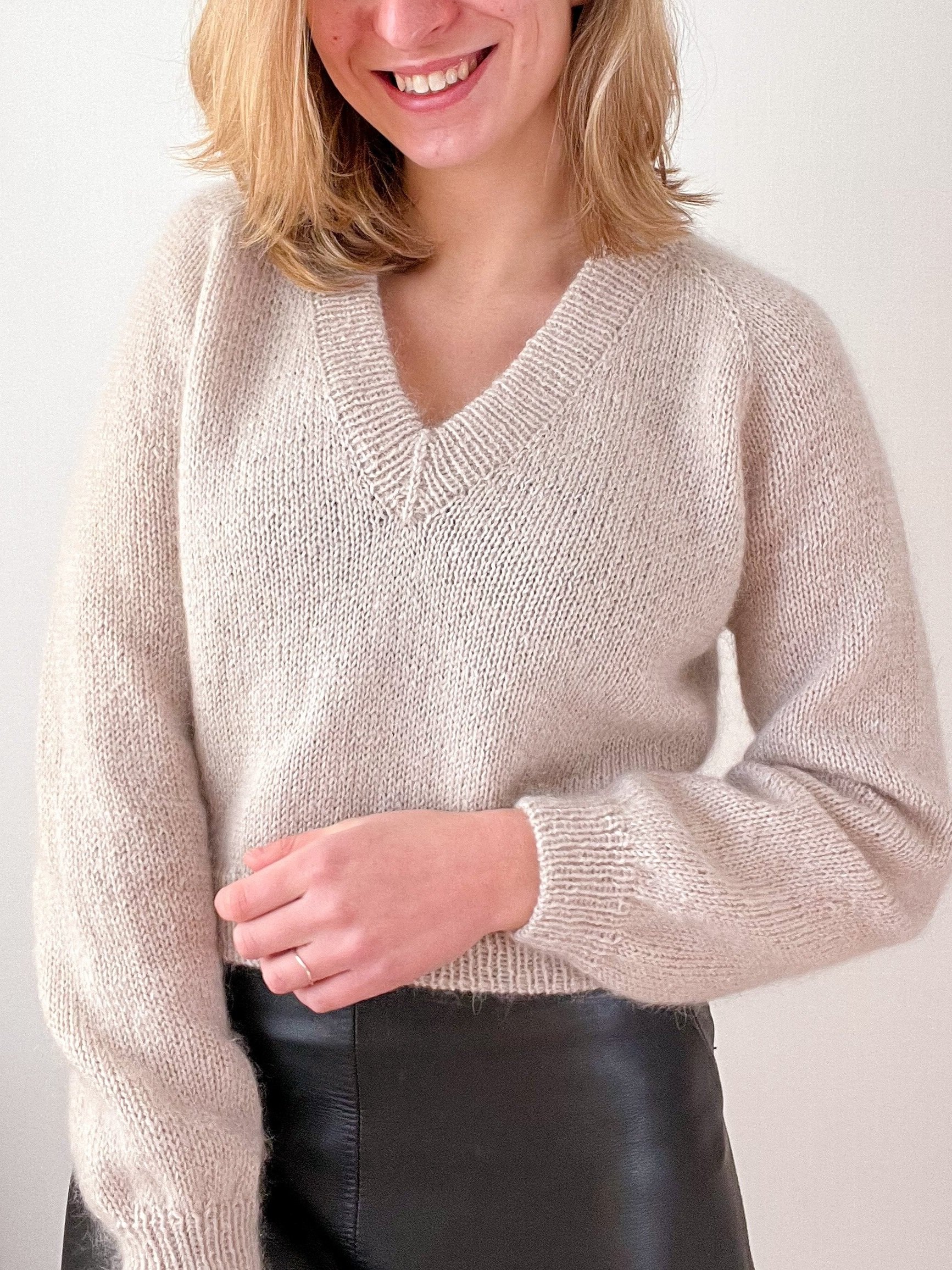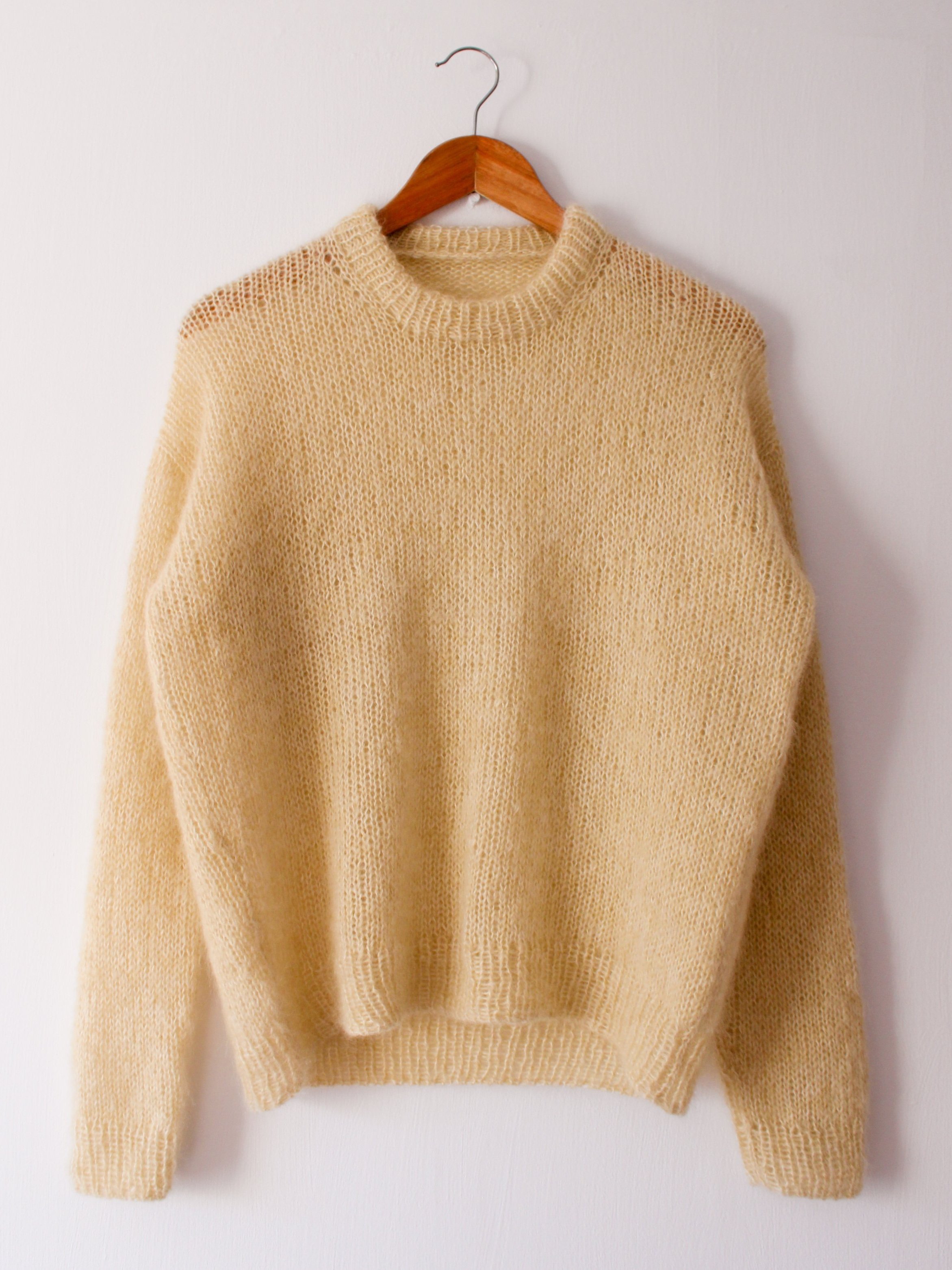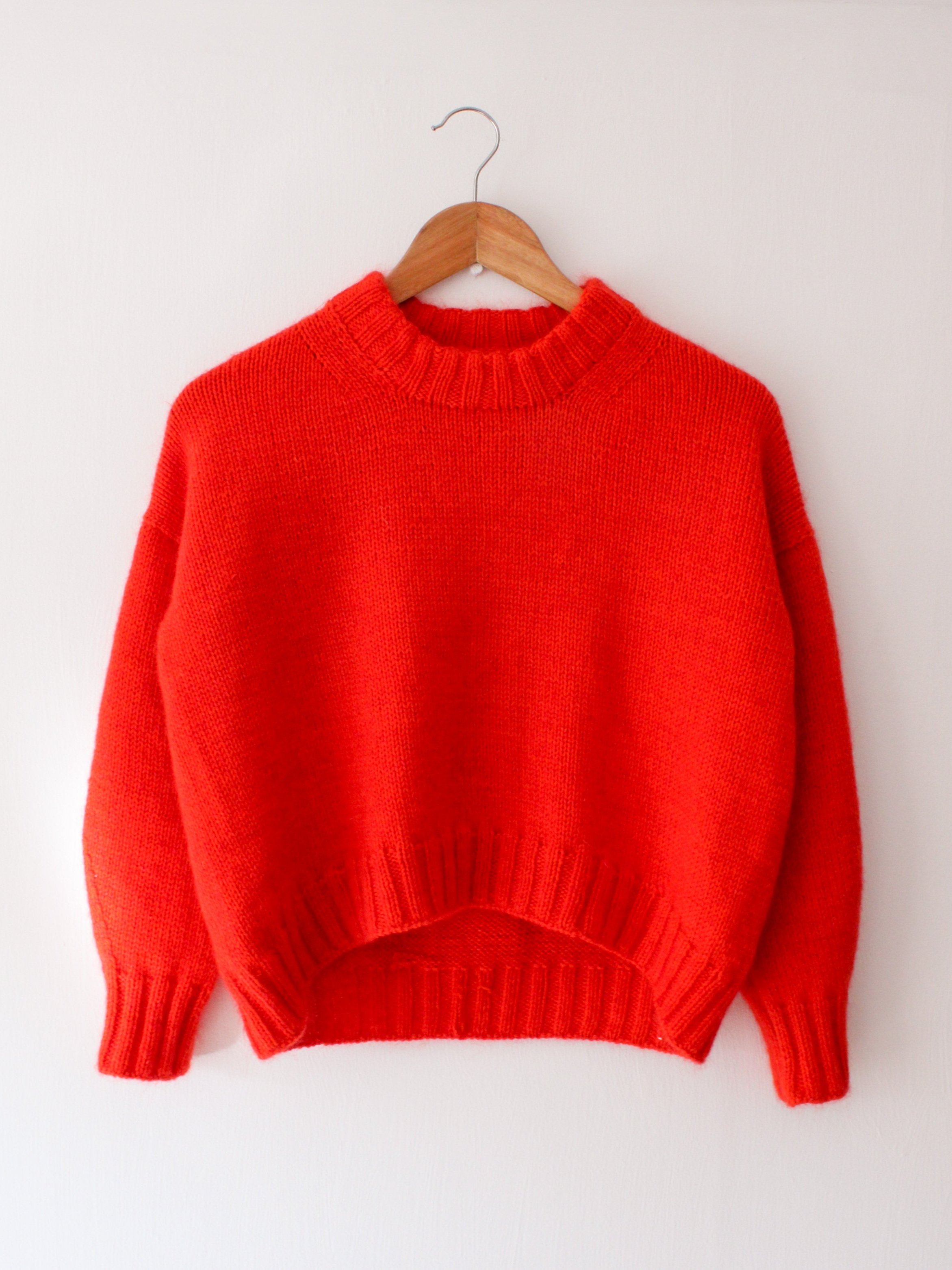Saltburn Sweater
The Saltburn Sweater is worked top down and in the round. It has a circular yoke which is decorated with stranded colourwork. The colourwork is fairly simple to work, and there are only a couple of rounds which require a lot of float-catching. You will begin by working the stranded colourwork part of the yoke and will then finish the yoke with some German short rows. Next, you divide the yoke into body and sleeve sections and you will work the body whilst the sleeves rest. You will then resume working the sleeves and finish by applying the collar in 2x2 rib, to match the cuffs and hem.
This pattern has been tech edited and graded by Rebecca Williamson.
Please note that this is a digital pdf download and not a physical knitting pattern.
For pattern support, please email the.knit.purl.girl2020@gmail.com or use the contact form on this website. Thank you!
The Saltburn Sweater is worked top down and in the round. It has a circular yoke which is decorated with stranded colourwork. The colourwork is fairly simple to work, and there are only a couple of rounds which require a lot of float-catching. You will begin by working the stranded colourwork part of the yoke and will then finish the yoke with some German short rows. Next, you divide the yoke into body and sleeve sections and you will work the body whilst the sleeves rest. You will then resume working the sleeves and finish by applying the collar in 2x2 rib, to match the cuffs and hem.
This pattern has been tech edited and graded by Rebecca Williamson.
Please note that this is a digital pdf download and not a physical knitting pattern.
For pattern support, please email the.knit.purl.girl2020@gmail.com or use the contact form on this website. Thank you!
The Saltburn Sweater is worked top down and in the round. It has a circular yoke which is decorated with stranded colourwork. The colourwork is fairly simple to work, and there are only a couple of rounds which require a lot of float-catching. You will begin by working the stranded colourwork part of the yoke and will then finish the yoke with some German short rows. Next, you divide the yoke into body and sleeve sections and you will work the body whilst the sleeves rest. You will then resume working the sleeves and finish by applying the collar in 2x2 rib, to match the cuffs and hem.
This pattern has been tech edited and graded by Rebecca Williamson.
Please note that this is a digital pdf download and not a physical knitting pattern.
For pattern support, please email the.knit.purl.girl2020@gmail.com or use the contact form on this website. Thank you!
Materials & Fit
Notions: 3.5 mm [US 4] (40-cm [16-in] cord), 4 mm [US 6] (40-, 80- and/or 100-cm [16-, 32- and/or 40-in] cord), and 5 mm [US 8] (40-, 60-, 80-, and 100-cm [16-, 32- and/or 40-in] cord) circular needles. You may also find some 4 mm [US 6] and 5 mm [US 8] double-pointed knitting needles useful for the sleeves, but they are not strictly necessary.
You will also need a few stitch markers, a darning needle, and some spare needles/scrap yarn/stitch holders where the stitches of the sleeves will rest. I would also recommend having some clip-on markers at hand.
Yarn: I recommend that you use Sandnes Garn Peer Gynt (100% Norwegian wool; 50 g = 91 m [100 yds]). You will need at least two colours of yarn for this project: your main colour and your contrast colour.
You will need approximately 8 (8) 8 (9), 10 (10) 10 (11), 11 (12) 13 (14) skeins of Peer Gynt in your main colour, and 2 (2) 2 (2), 2 (2) 2 (2), 2 (2) 2 (2-3) skeins of Peer Gynt in your contrast colour. I have tried to be generous with these estimates and have based them on the yarn I used to make my sample, the grading, and the testers’ feedback on yardage. However, I recommend erring on the side of caution when buying your yarn to avoid issues with dye lots.
If you wish to substitute a different yarn, I estimate that each size will need 650 (675) 725 (775), 825 (850) 875 (925), 975 (1,050) 1,125 (1,225) m [72 (740) 800 (850), 920 (930) 960 (1,020), 1,070 (1,150) 1,230 (1,340) yds] of your main colour and 150 (150) 150 (150), 150 (160) 160 (170), 180 (180) 190 (200) m [170 (170) 170 (175), 170 (180) 180 (190), 200 (200) 210 (220) yds]. Please note that I have rounded the figures here up to the nearest 10 m [10 yds] for ease of reference.
Yarn alternatives: Any robust DK- or light aran-weight yarn will work well here. You’ll want something with a good amount of stitch definition, and I would generally recommend more “rustic” yarns for this sweater. The main option which comes to mind is Isager Jensen (100% wool; 50 g = 125 m). It is slightly finer than Peer Gynt but the feeling is quite similar and I achieve the same gauge in Stockinette stitch with both yarns. Garthenor No. 3 (100% organic breed-specific wool; 50 g = 90-115 m [98.5-125.5 yds]) would also be wonderful if you wanted a more natural palette. If you wanted something a bit softer than British or Nordic wools, I would recommend looking at Knitting For Olive Heavy Merino (100% merino wool; 50 g = 125 m [136.5 yds]). It is slightly finer and less lofty than the yarns otherwise mentioned here but I think it should work quite well. If you wanted a superwash option, Along Avec Anna Double Merino (100% superwash merino wool; 50 g = 108 m [118 yds]) is lovely.
When I first made this sweater (in a size roughly equivalent to Size C and made with the shades Marzipan Melange 977 and Christmas Red 225 as main and contrast colours respectively), I used Filcolana Peruvian Highland Wool (100% Peruvian highland wool; 50 g = 100 m [109 yds]). This yarn is quite budget-friendly and the weight is a close match to Peer Gynt, but I have found that this yarn pills a lot without a strand of mohair (which I don’t recommend for this pattern), so I can’t wholeheartedly recommend it.
Tension: 17 stitches x 24 rounds in Stockinette stitch on 5 mm [US 8] needles = 10 x 10 cm [4 x 4 in]. Make sure to wash and block your swatch for the most accurate results. You may wish to go up or down a needle size, working in 0.25/0.5 mm [US 0.5] increments as needed to meet gauge. Please also be mindful that stranded colourwork can impact your tension, so it is important to also swatch in pattern.
Sizing and ease: The Saltburn Sweater has a recommended positive ease of between 0-10 cm [0-4 in]. If you would prefer more or less ease, however, feel free to change size to achieve your desired fit. Use the schematic below to find your size based on your chest measurement.
Size: A (B) C (D), E (F) G (H), I (J) K (L)
Chest measurement (cm): 75-80 (80-85) 85-90 (90-95), 95-100, (100-105) 105-110 (110-115), 115-125 (125-135) 135-145 (145-155)
Chest measurement (in): 29.5-31.5 (31.5-33.5) 33.5-35.5 (35.5-37.5), 37.5-39.25 (39.25-41.25) 41.25-43.25 (43.25-45.25), 45.25-49.25 (49.25-53.25)
53.25-57 (57-62)
Actual circumference of garment (cm): 84.5 (89.5) 96.5 (101), 108 (113) 115.5 (120), 127 (136.5) 146 (155.5)
Actual circumference of garment (in): 33.25 (35.25) 38 (39.75), 42.5 (44.5) 45.5 (47.25), 50 (53.75) 57.5 (61.25)
Actual yoke depth (cm): 20 (20.5) 21 (21.5), 22 (22.5) 22.5 (23), 24 (24.5) 25.5 (26.5)
Actual yoke depth (in): 7.75 (8) 8.25 (8.5), 8.75 (8.75) 8.75 (9), 9.5 (9.75) 10 (10.5)
Sleeve circumference at upper bicep (cm): 33 (34) 35.5 (37.5), 37.5 (39) 31 (42.5), 43.5 (48) 50.5 (56.5)
Sleeve circumference at upper bicep (in): 13 (13.5) 14 (14.75), 14.75 (15.25) 16.25 (16.75), 17.25 (19) 20 (22.25)
Recommended sleeve length (cm): 45, with options to modify included in the pattern
Recommended sleeve length (in): 18, with options to modify included in the pattern
Recommended length from bottom of collar to hem (cm): 48 (49) 50 (51), 52 (53) 54 (55), 57 (58.5) 60 (61.5)
Recommended length from bottom of collar to hem (in): 19 (19.25) 19.75 (20), 20.5 (20.75) 21.25 (21.75), 22.5 (23) 23.5 (24.25)
Please note that all measurements in centimetres are rounded to the nearest 0.5 cm, and all measurements in inches are rounded to the nearest 0.25 inch. Adjusting the length of the garment significantly will affect the amount of yarn needed.
Techniques include working in the round, two-stranded colourwork, reading knitting chart, German short rows, a sewn cast-off in 2x2 rib, and working an applied folded collar.
